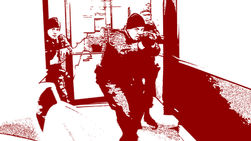Article: Moving toward recovery
- Lee
- Feb 12, 2015
- 2 min read

Mandy Hinkle has been in and out of therapy since she was six years old, trying to cope with the aftermath of childhood abuse. But, she says, the catalyst for her healing came when she tried “dancing mindfulness”—a new approach to trauma therapy that combines the neurological benefits of certain movements with focused mindfulness training.
“Talk therapy can only do so much,” she says. “With me, there’s an energy that gets blocked that talking couldn’t seem to solve. There’s a catharsis with this, a release.”
Psychologist Jamie Marich, the creator of dancing mindfulness, says the secret to its effectiveness is bilateral movement—a side-to-side motion that triggers calming centers of the brain.
Psychologists have been using controlled bilateral movement to treat trauma disorders since the early 1990s. Early research showed that trauma survivors exhibited erratic eye movements when experiencing a disturbing memory. When those patients were instructed to focus on side-to-side eye movements instead, it was shown to be as effective as more established treatments like cognitive behavioral therapy in reducing the intensity of those disturbing memories. And more recent research suggests that bilateral body movement is as effective as eye-movement control in treating trauma.
Marich’s dancing mindfulness program combines that clinical approach with elements of yoga and Eastern philosophy to create a practice that promotes calmness and, for some, lays the foundation for trauma recovery.
Group sessions begin with seated, focused breathing techniques, and side-to-side stretches.
As music is introduced, Marich encourages the group to explore the small, natural body movements that happen in response to the sound.
“Micromovements are totally beautiful,” Marich says, defining these initial stirrings. “They’re the very foundation of dance.”
The tempo and intensity of the music steadily build into standing, free-form dance—the core of the session and the practice that guides participants to be fully present. “One thing we find challenging is that some people we see have never learned how to live in the now,” Marich says. “We incorporate these elements of yoga and meditation into dancing mindfulness to help them.”
Hinkle, a yoga instructor who has collaborated with Marich on several donation-based workshops, says the freedom of movement in a dancing mindfulness session helps her to focus on being present.
“You have to give over to the process and the basic aspects of mindfulness,” Hinkle says. “The nonjudgment, the nonstriving. If you do that, something great happens.”
Dancing mindfulness can be practiced one-on-one with a facilitator, in a group class, or alone. Marich has also produced a DVD for people interested in the practice who are unable to find a local facilitator.
“Mindfulness teaches those who practice it to stay in the moment,” Marich says. “We live in a culture that doesn’t promote that, which can lead pretty heavily to stress.”
See the full article here:
http://spiritualityhealth.com/articles/moving-toward-recovery














Comments